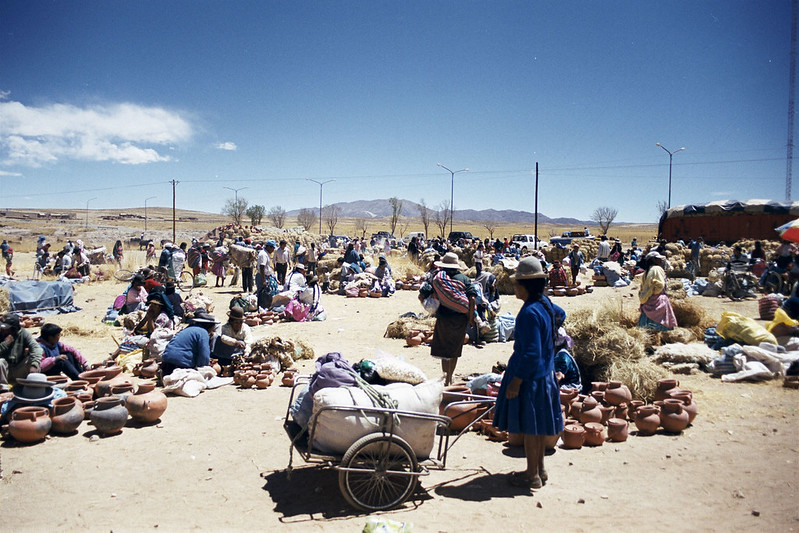Manca Fiesta
The Festival of Clay Pots and Community in the Andean Highlands
2026/10/17 - 2026/10/24
Every October, the highland city of La Quiaca in northern Jujuy, Argentina, comes alive with the Manca Fiesta, or “Festival of the Clay Pots.” For several days, producers and artisans from Jujuy, Salta, and southern Bolivia gather to barter handmade clay pots, woven textiles, potatoes, beans, cheese, and more, sharing traditional foods and celebrating Andean culture. The market buzzes with lively conversation, folk music, the clinking of pots, and the aromas of roasted corn and stews, creating a feast for the senses.
The Manca Fiesta is held annually on the third or fourth Sunday of October in La Quiaca, welcoming local families, traveling merchants, and tourists alike. It’s a unique opportunity to witness generations-old barter in action, taste regional flavors, and experience the warmth and resilience of Andean communities.
Main Attractions
The Great Barter Market
At the heart of the festival is the open-air barter market. Clay pots (“manca”), textiles, potatoes, beans, and homemade cheese are exchanged, strengthening ties between producers and artisans. The market is vibrant and colorful, with mules and donkeys carrying goods and blue tarps shading the old railway grounds, creating a unique Andean scene.
Cultural and Historical Background
The history of Manca Fiesta traces back to the indigenous societies of the Andean highlands. During the Inca Empire, this region was a key stop on the Qhapaq Ñan (Inca Road), where agricultural products and handicrafts were brought from afar and lively trade flourished. The “manca” (Quechua for clay pot) was used as a unit of barter, with potatoes, beans, corn, cheese, and textiles commonly traded “by the pot.”
Even after the Spanish colonial period, when cash economies had not fully reached the highland villages, barter markets remained central to daily life. Manca Fiesta became the year’s largest gathering for distant farmers, artisans, and merchants to meet and exchange goods. Hundreds of blue tarps are still stretched across the old railway station and surrounding plazas, and people arrive by mule, donkey, or llama—sometimes crossing the border from Bolivia—creating a scene that has changed little over generations.
The festival is more than just a barter market; it embodies the Andean values of “ayni” (mutual aid) and “minka” (collective work). Families, relatives, and old friends reunite, sharing meals, music, and rituals of gratitude to Pachamama (Mother Earth), which strengthens the bonds of the community. In recent years, producers from both Bolivia and Argentina have participated, making the event an international gathering that transcends borders.
Even today, with the rise of supermarkets and commercial distribution, Manca Fiesta remains a vital annual event for preserving regional identity and tradition, cherished by many as a living link to their heritage.
Fun Facts
- “Manca” means “clay pot” in Quechua and was originally the standard measure for barter.
- Until the 1980s, most traders arrived by mule, donkey, or llama, carrying goods across the highlands.
- The festival is held at the old La Quiaca railway station, with blue tarps marking the market area.
Festival Dates
Manca Fiesta is held every October in La Quiaca, Jujuy, Argentina, peaking on the third Sunday.
The event schedule is subject to change. Please check the official website for the most up-to-date information.
Information
| Name | Manca Fiesta |
| Country | Argentina |
| Area | La Quiaca |
| Date | 2026/10/17 - 2026/10/24 |
| Link |
Upcoming Festivals
Dia de la Virgen de Guadalupe Mexico
A Festival Weaving Faith, Fervor, and Mexican Identity
2025/12/11L'Escalade Switzerland
Geneva’s Grand Winter Festival of Courage, Chocolate, and Community
2025/12/12Umkhosi Wokweshwama South Africa
The Zulu First Fruits Festival—A Sacred Celebration of Land, Ancestors, and Renewal
2025/12/12Lucia Festival (St. Lucia's Day) Sweden
A Festival of Light Illuminating the Nordic Darkness
2025/12/15Las Posadas Mexico
The Luminous Quest for Sacred Shelter
2025/12/22Noche de Rabanos (Night of the Radishes) Mexico
A celebration blending art, farming heritage, and cultural traditions
2025/12/23Chant of the Sybil on Majorca Spain
A Medieval Prophecy Echoes Through Majorcan Christmas
2025/12/23‘Hatajo de Negritos’ and the ‘Hatajo de Pallitas’ Peru
A Christmas Festival of Rhythm, Faith, and Afro-Andean Heritage in Peru’s Ica Region
2025/12/24Harbin International Ice and Snow Sculpture Festival China
A Frozen Wonderland Where Art and Adventure Merge
2025/12/24Takanakuy Peru
The Andean Festival of Reconciliation by Fist—How Confrontation Creates Year-End Peace and Bonds
